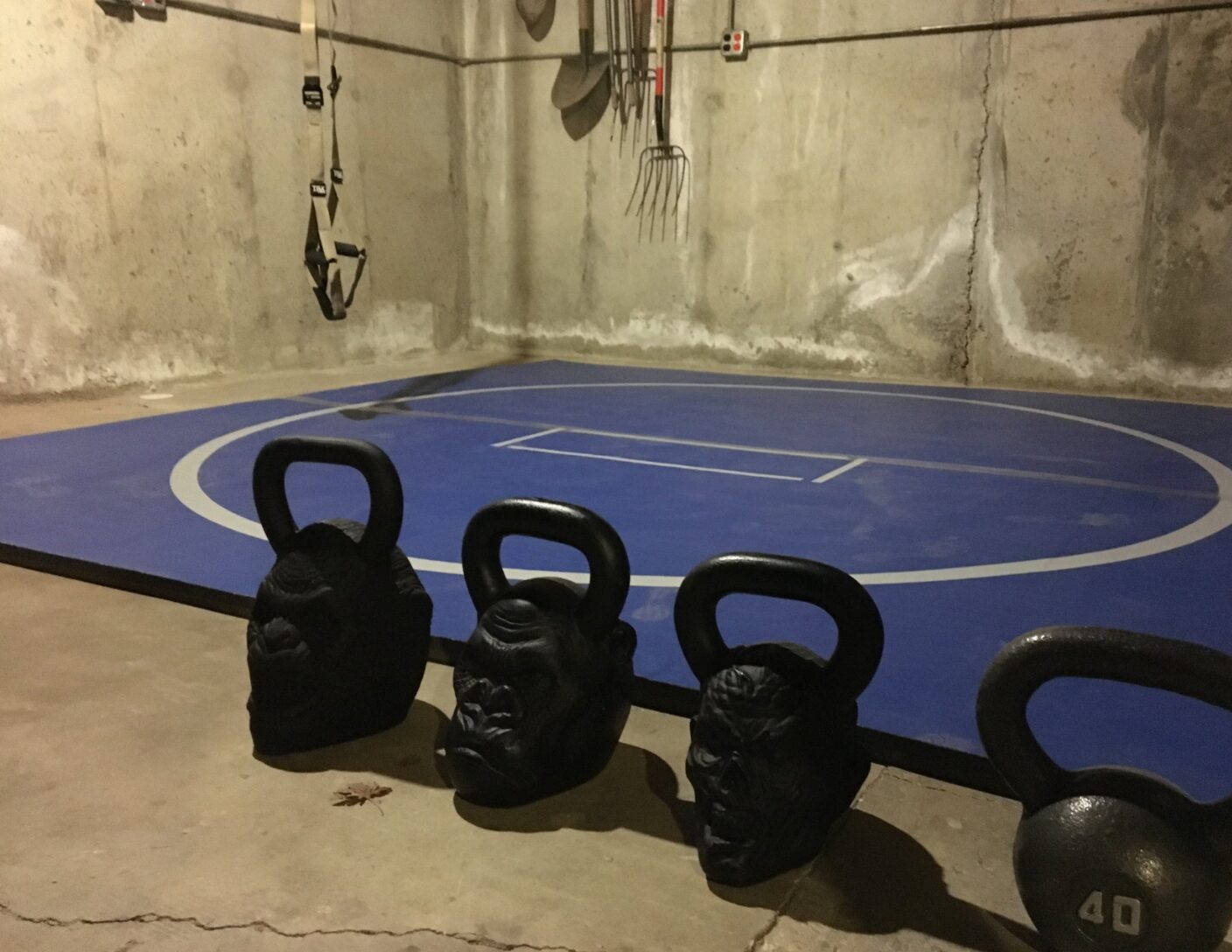The time comes when a man cuts ties with the church of iron. Turning in membership key fob, losing the shaker ball, and increasing one’s focus on squat rack avoidance; the chosen become journeyman in the way of strength: Ronin of resistance. This serendipitous adjustment provided me with laboratory and experiment necessary for understanding optimization in balancing the exalted holy triad: muscle, strength, and function. Although I am a proponent of the dumbbells, barbells, and sometimes even machines, I’ve discovered through self imposed austerity a simpler approach of “the way”. Relegating the self to a few kettle bells and body weight calisthenics I’ve unknowingly accessed a hidden mode, catalyzing all metrics of the aforementioned triad to unprecedented levels of performance. This genesis of training began to have wild implications following my trading of mirrored rows of beaming fluorescence on rubberized dumbbells to dingy farm doored basements in a rural small town. Following the emancipation from church, I’ve been proselytized as member and leader of a cult of kettle balls and the good word of gains and function must be heard. Although, like many things in life this gained knowledge was not by way of chance or falling into knowledge. Rather, a strategy sought after by learning the ways of mentors and the empiricism of training. In effort to spreading this gospel, and as many of us find our gyms less hospitable due to dictator mandates flippantly trebulched into our lives, I’ve collated notes from various interviews with The Comrad of kettles himself: Pavel Tsatsouline. The below curated excerpts are distilled axioms of his strength teachings followed with an interesting slow twitch & generalized strength protocol that piqued my interest and has certainly influenced my strength practice & success on the mats.
Notes from various Pavel Interviews:
Do not workout: Practice strength. Strength is a skill, and like all skills requires practice.
-Biggest misconception of strength: going to failure every time. Soviet Lifting System: do 1/3 to 2/3 of total max repetitions possible. Doing more sets instead of reps. Safer, increased progress, and more fun.
-Many layer fitness upon disfunction (think carefully of this). Rest longer in between sets to practice strong form and discipline of movement; make every rep count.
-Strength is about muscular contraction. Most are only able to consciously control 20% of skeletal muscles. Elites index in the range of 2x of most. Focus on muscular contraction.
Irradiation: increase strength by bracing the core and creating tension locally & globally. I.E. when gripping the kettle bell for a max attempt, be sure to brace the core, tighten the grip, and irradiate the involved kinetic chain (depends on the exercise). Be very present during the lift. Respect the weight and give full it your attention. Analogous to meditation, strength training is a practice.
Strength First. Greater strength increases performance in all domains. Perceived level of endurance in many activities decreases from dedicated strength practice. Strength also aids in losing weight, creating larger metabolic furnace enabling increased load thresholds which increases demand for fuel during and after practicing. Snake eating the snake
-Strength will carry over to endurance. the opposite does not apply: Endurance does not carry over to strength. Doing heavy deadlifts will help with carrying kegs up stairs. Hammering nails all day will not convert over to better sustained lifting of gravel filled buckets. Meditate on this.
Tools of Training:
- Bodyweight: requires the most coaching for proper execution. Can’t train lower back effectively.
- Kettlebell: direct application to sport specificity. Easier to work around injuries, Offset center of gravity challenges the body in ways the barbell cannot. Kettlebells allows for more ballistic oriented movements and perfect for contact sports.
- Barbell: psychologically satisfying. Best tool for developing muscle mass. Barbell does not adjust to the body, the body must adjust to the tool. Can be a problem for injuries.
- Flexibility is tension governed by nervous system. Stretch reflex fires because nervous system is habituated to be cautious in assessed compromised positions.
Periodization: training structured with peak performance at the end of cycle.
Types of Periodized Loading:
Step Loading: stay at same weight for weeks, then jump up and repeat cycle. Facilitates adaptations to be more stable. Best for beginners.
Wave Loading: multiple week program progressively increasing weight in up-wave (think high frequency or top of wave) and strategically reducing weight in a low-wave (think trough or bottom of wave) before returning to increased weight at up-wave (my interpretation being arduous recovery work). Endocrine system can manage 2 out of 4 weeks of heavy limit lifting. Wave loading “solidifies the gains” ensuring the slower adapting endocrine and ligament / tendon system can keep up with demand.
Variable Overload: certain load parameters set prior: I.E. average training weights being 75% of max I.E. Variable load jumps are delta 20% and “chaotic” in programming. Tail ends of normal distribution curve will contain lifts that are max in effort and or velocity and low in challenge (recovery or isometric); majority of bell curve will be in the 75% of max area. Most changes in body are discrete, not gradual (think of demands on ancient hunter & gather lifestyles). Strength can be viewed as being previously a tool of safety and means of attaining resource. Training must be highly variable much like the primal landscape. Not constantly going up, but more dimensions in directionality. We evolved from these intermittent gains.
Studies of training modes in top lifters for 4 Olympic cycles (16 years); a focus of winners supports Variable Overload protocol. Average intensity 75% of max (8-10 reps); encompasses more than half of all lifts. Proper volume: 1/3 to 2/3 of max. I.E. if max is 10 reps, aim for 3-6 reps; roughly half the reps you are capable. Universally effective for intermediate lifters.
Greasing the Groove
Practicing strength when fresh, training optimum performance not form of the fatigued.
Protocol: 3x per week. 3-5 sets of 3-5 reps 5-15 min rest between each set (for Abs hold for 10 sec I.E. plank). Heavy focus on contraction. Fastest way to strength via any domain aimed at. GTG encourages high level of motor neuron recruitment and teaching the body to practice good form. Not a focus on hypertrophy. I.E. doing pull up sets in between sending emails. Should not even develop a sweat. Avoid the burn: hydrogen ions (waste product from cellular respiration) interfere with neurological command. Fight the adage of burn being a test of mental strength and indicator of a “good workout”. Purportedly, the overburden of these waste products caused by not allowing proper recovery between sets or too many reps results in the muscular trauma and potentially causing actin and myosin cross bridges to stick.
Hypertrophy of Slow Twitch Fibers.
Slow Twitch Fiber Protocol: endurance / wrestler strength. Slow fibers and fast equally strong (50% lower body composition & 25% upper body). Velocity is the difference. 50% of output in sprint is slow fiber.
Sample of sprinter training slow fiber protocol advanced their ability to sprint 100m 10.7-10.9 second improvement.
Protocol: Focus on exhausting creatine phosphate fuel using occlusion; contraction preventing blood flow. Above and below full range of motion equates constant tension & occlusion. 30-60 seconds duration during each set (typically 30-60% max weight lower body & 10-40% max weight upper body). Close to failure and very slow. 5-10 min rest. 4-9 sets first day. 3-4 day later: 1-3 sets. active rest 5-10 min (can work other muscle groups).
Back squat protocol (8 weeks): 25% added to weight. these were experienced athletes.
Lower body: use back or front squat
Upper body: use diamond pushups: not in lock out and not at bottom. working midrange of movement.














